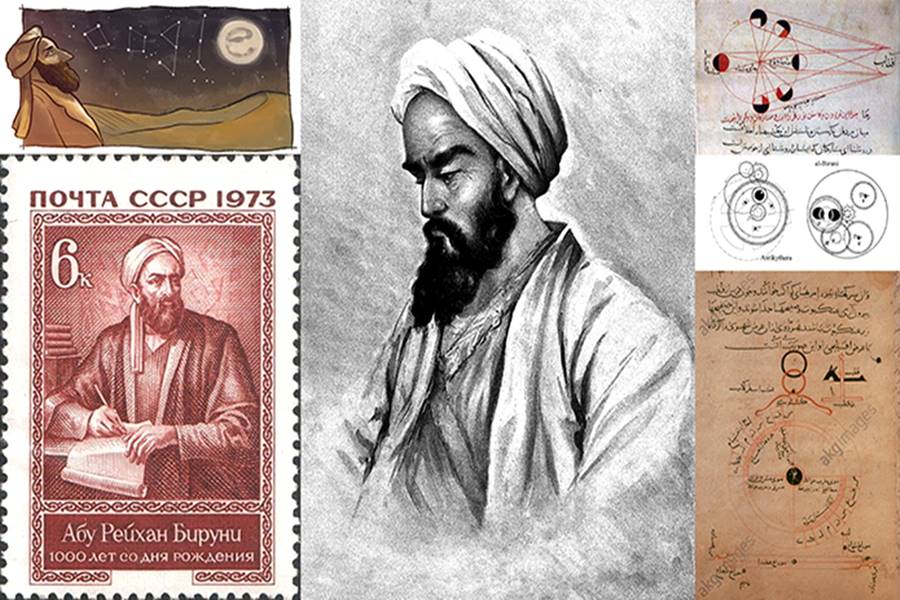Sun 07 March 2021:
He elevated mathematics to a level where it embraced and complemented the laws of nature.
Calculating the radius of the earth over a thousand years ago required a lot of imagination. It was Abu Reyhan Al-Biruni, the 10th century Islamic mathematical genius, who combined trigonometry and algebra to achieve this very numerical feat.
Biruni’s scholarly legacy has inspired scientists and mathematicians for several centuries, and his name continues to command respect even today.
In 1975, the famous Tajik academician, Bobojon Gafurov, described Biruni in his Unesco Courier article as an universal genius who “was so far ahead of his time that his most brilliant discoveries seemed incomprehensible to most of the scholars of his days”. George Sarton, the founder of the History of Science discipline, named the 11th century as the Al Biruni Age.
Scholars like Biruni were born at a time when much of the world’s scientific and mathematical knowledge was translated into Arabic. By the time he came of age, he was also introduced to concepts developed by scholars from different civilisations and centuries. From the scientific literature of the Babylonians to those of the Romans, to ancient Indian texts on astrology, Biruni learnt from it all. Like other Muslim scholars from the Golden Age of Islam, he was also hungry for knowledge.
According to the Turkish Professor, Fuat Sezgin, intellectually sound debates occurred between the 27-year-old Biruni and 18-year-old Ibn Sina. The two great minds are known to have discussed ‘The propagation of light and its measurement’ in a great depth. Sezgin, who died in 2018, concluded that the quality of those debates is rare and probably does not exist even today.
Delving into the content of some of those historic debates, Sezgin said the two polymaths exchanged notes on heat and rays. Both scholars had come to a similar conclusion — that heat is generated by motion and cold by rest, and for this reason, the earth is hot at the Equator and cold at the Poles. Another aspect they debated was the propagation of heat rays of the sun. Biruni saw light and heat as immaterial, and opined that the heat exists within the rays.
Ibn Sina went further still, and said that heat does not propagate by itself, but that the rays of the sun carry them along — like a man sitting still in a moving boat.
According to German historian, Max Meyerhoff, Biruni is perhaps the most prominent figure in the phalanx of universally revered Muslim scholars, and whose contributions in so many diverse fields earned him the title “al-Ustadh,” the Master or Professor par excellence.
Back to the earth’s radius- just how did he measure it? It was certainly his most remarkable achievement. He first measured the height of a hill near the Fort of Nandana in today’s Punjab province of Pakistan. He then climbed the hill to measure the horizon. Using trigonometric and algebraic equations, he got the value equivalent to 3928.77 English miles, which is about 99 percent close to today’s radius of the earth.
Based on his calculations, Biruni also began to think about the possibility of the earth revolving around the sun, an idea polymaths of that time would ignore. But Biruni was so sure about his logic and instincts, that he extensively wrote about the sun, its movements and the eclipse. In addition, he invented astronomical instruments, and described how the earth rotated on an axis, making accurate calculations of latitude and longitude. He noted down his theories and observations in his book, “Al-Athar Al-Baqiya.” He also wrote a treatise on how timekeeping occurred in 1000 C.E, the period also known as the Christian Era.
He also discovered several ways of finding north and south, and discovered mathematical techniques to determine exactly the beginnings of the seasons.
Biruni observed the solar eclipse of April 8, 1019, and the lunar eclipse of September 17, 1019. The former he saw at Lamghan, a valley surrounded by mountains between the towns of Qandahar and Kabul. He wrote; “At sunrise we saw that approximately one-third of the sun was eclipsed and that the eclipse was waning”.
He observed the lunar eclipse at Ghazna and gave precise details of the exact altitude of various well-known stars at the moment of first contact. He also described the Milky Way as a collection of countless fragments of nebulous stars.
In the book, “Al-Tafhim-li-Awail Sina’at al-Tanjim,” he summarised his work on Mathematics and Astronomy. It was translated by Ramsay Wright in 1934.
Biruni’s contributions to physics include work on springs and accurate determination of the specific weight of eighteen elements and compounds including many metals and precious stones. His book “Kitab-al-Jamahir” discusses the properties of various precious stones. He was a pioneer in the study of the angles and trigonometry. He worked on shadows and chords of circles, and also developed a method for trisecting an angle. He elaborated on the principle of position and also discussed the Indian numerals.
In the fields of geology and geography, Biruni contributed to geological eruptions and metallurgy. He explained the working of natural springs and artesian wells by the hydrostatic principle of communicating vessels. In light of his scholarly work, he was called the founder of geodesy. His book Al-Athar Al-Baqiyah fi Qanun al-Khaliyah, deals with ancient history and geography, and it was translated by Edward Sachau.
Al-Biruni’s life
Born in Kath, Khwarezm in Western Central Asia, he lived between 973 and 1048. Khwarezm was the country of the Khwarezmian civilization and of several kingdoms. Parts of it now belong to Uzbekistan, Kazakhstan and Turkmenistan.
Biruni left his hometown at a young age and he wandered around Persia and Uzbekistan. Then, after Mahmud of Ghazni conquered the emirate of Bukhara, he moved to Ghazni, a town in today’s Afghanistan, which served as the capital of the Ghaznavid dynasty.
Biruni is most commonly known through his close association with Mahmood Ghaznavi, a famous Muslim king who also ruled India, and his son Sultan Masood. Impressed by his scholarship and fame, Sultan Mahmood Ghaznavi took Biruni along with him on his journeys to India several times. Biruni traveled to many places in India over 20 years, and studied Hindu philosophy, Mathematics, Geography and religion from the Pundits. In return, he taught them Greek and Muslim sciences and philosophy.
Considering Islamic teaching as a cornerstone of his scientific catalogue, Biruni summarised his quest for knowledge in the following way: “My experience in the study of astronomy and geometry and experiments in physics revealed to me that there must be a Planning Mind of Unlimited Power. My discoveries in Astronomy showed that there are fantastic intricacies in the universe which prove that there is a creative system and a meticulous control that cannot be explained through sheer physical and material causes”.
He never exploited his work as a means to achieve fame, authority or material gains. When Sultan Masood sent him three camel-loads of silver coins in appreciation of his encyclopedic work “Al-Qanoon al-Masoodi,” (The Mas’udi Canon), Al-Biruni politely returned the royal gift saying, “I serve knowledge for the sake of knowledge and not for money.”






